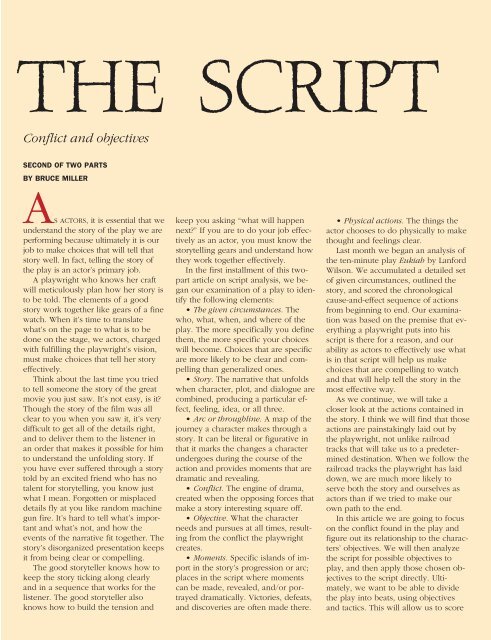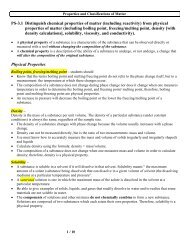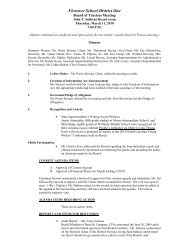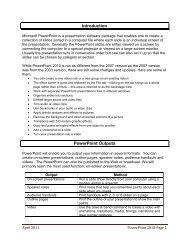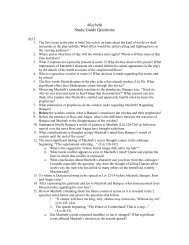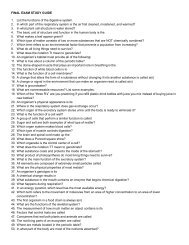DRAMATICS ⢠NOVEMBER 2005
DRAMATICS ⢠NOVEMBER 2005
DRAMATICS ⢠NOVEMBER 2005
Create successful ePaper yourself
Turn your PDF publications into a flip-book with our unique Google optimized e-Paper software.
THE SCRIPT<br />
Conflict and objectives<br />
SECOND OF TWO PARTS<br />
BY BRUCE MILLER<br />
AS ACTORS, it is essential that we<br />
understand the story of the play we are<br />
performing because ultimately it is our<br />
job to make choices that will tell that<br />
story well. In fact, telling the story of<br />
the play is an actor’s primary job.<br />
A playwright who knows her craft<br />
will meticulously plan how her story is<br />
to be told. The elements of a good<br />
story work together like gears of a fine<br />
watch. When it’s time to translate<br />
what’s on the page to what is to be<br />
done on the stage, we actors, charged<br />
with fulfilling the playwright’s vision,<br />
must make choices that tell her story<br />
effectively.<br />
Think about the last time you tried<br />
to tell someone the story of the great<br />
movie you just saw. It’s not easy, is it?<br />
Though the story of the film was all<br />
clear to you when you saw it, it’s very<br />
difficult to get all of the details right,<br />
and to deliver them to the listener in<br />
an order that makes it possible for him<br />
to understand the unfolding story. If<br />
you have ever suffered through a story<br />
told by an excited friend who has no<br />
talent for storytelling, you know just<br />
what I mean. Forgotten or misplaced<br />
details fly at you like random machine<br />
gun fire. It’s hard to tell what’s important<br />
and what’s not, and how the<br />
events of the narrative fit together. The<br />
story’s disorganized presentation keeps<br />
it from being clear or compelling.<br />
The good storyteller knows how to<br />
keep the story ticking along clearly<br />
and in a sequence that works for the<br />
listener. The good storyteller also<br />
knows how to build the tension and<br />
keep you asking “what will happen<br />
next?” If you are to do your job effectively<br />
as an actor, you must know the<br />
storytelling gears and understand how<br />
they work together effectively.<br />
In the first installment of this twopart<br />
article on script analysis, we began<br />
our examination of a play to identify<br />
the following elements:<br />
• The given circumstances. The<br />
who, what, when, and where of the<br />
play. The more specifically you define<br />
them, the more specific your choices<br />
will become. Choices that are specific<br />
are more likely to be clear and compelling<br />
than generalized ones.<br />
• Story. The narrative that unfolds<br />
when character, plot, and dialogue are<br />
combined, producing a particular effect,<br />
feeling, idea, or all three.<br />
• Arc or throughline. A map of the<br />
journey a character makes through a<br />
story. It can be literal or figurative in<br />
that it marks the changes a character<br />
undergoes during the course of the<br />
action and provides moments that are<br />
dramatic and revealing.<br />
• Conflict. The engine of drama,<br />
created when the opposing forces that<br />
make a story interesting square off.<br />
• Objective. What the character<br />
needs and pursues at all times, resulting<br />
from the conflict the playwright<br />
creates.<br />
• Moments. Specific islands of import<br />
in the story’s progression or arc;<br />
places in the script where moments<br />
can be made, revealed, and/or portrayed<br />
dramatically. Victories, defeats,<br />
and discoveries are often made there.<br />
• Physical actions. The things the<br />
actor chooses to do physically to make<br />
thought and feelings clear.<br />
Last month we began an analysis of<br />
the ten-minute play Eukiah by Lanford<br />
Wilson. We accumulated a detailed set<br />
of given circumstances, outlined the<br />
story, and scored the chronological<br />
cause-and-effect sequence of actions<br />
from beginning to end. Our examination<br />
was based on the premise that everything<br />
a playwright puts into his<br />
script is there for a reason, and our<br />
ability as actors to effectively use what<br />
is in that script will help us make<br />
choices that are compelling to watch<br />
and that will help tell the story in the<br />
most effective way.<br />
As we continue, we will take a<br />
closer look at the actions contained in<br />
the story. I think we will find that those<br />
actions are painstakingly laid out by<br />
the playwright, not unlike railroad<br />
tracks that will take us to a predetermined<br />
destination. When we follow the<br />
railroad tracks the playwright has laid<br />
down, we are much more likely to<br />
serve both the story and ourselves as<br />
actors than if we tried to make our<br />
own path to the end.<br />
In this article we are going to focus<br />
on the conflict found in the play and<br />
figure out its relationship to the characters’<br />
objectives. We will then analyze<br />
the script for possible objectives to<br />
play, and then apply those chosen objectives<br />
to the script directly. Ultimately,<br />
we want to be able to divide<br />
the play into beats, using objectives<br />
and tactics. This will allow us to score<br />
<strong>NOVEMBER</strong> <strong>2005</strong> • <strong>DRAMATICS</strong>


